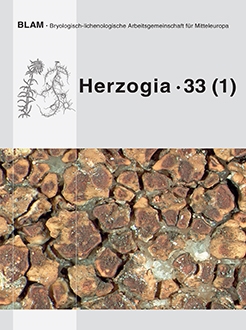Urbanavichus, G., Vondrák, J., Urbanavichene, I., Palice, Z. & Malíček, J. 2020. Lichens and allied non-lichenized fungi of virgin forests in the Caucasus State Nature Biosphere Reserve (Western Caucasus, Russia). – Herzogia 33: 90 –138.
We report on 659 epiphytic and epixylic species recorded from seven one-hectare plots established along an altitudinal gradient in a virgin forest of the Caucasus State Nature Biosphere Reserve. A total of 564 species are lichens, 61 are lichenicolous fungi and 34 are allied non- or facultatively lichenized fungi. one hundred forty – nine species (116 lichens, 17 lichenicolous and 16 saprophytic fungi) are new to the Northern Caucasus, including 133 species (104 lichens, 15 lichenicolous and 14 saprophytic fungi) that are new to the Caucasus Mountains. Fifty species are reported from Russia for the first time: 37 lichens (Andreiomyces obtusaticus, Bacidina mendax, Biatora aegrefaciens, B. bacidioides, B. chrysanthoides, Biatorella dryophila, Buellia iberica, Cliostomum haematommatis, Endohyalina ericina, Fellhanera christiansenii, Gyalidea minuta, Japewia aliphatica, Lecanora barkmaniana, L. subravida, Lecidea strasseri, Leptogium hibernicum, Lithothelium hyalosporum, L. phaeosporum, L. septemseptatum, Loxospora cristinae, Melanelixia epilosa, Micarea nowakii, M. perparvula, Opegrapha trochodes, Orcularia insperata, Parvoplaca servitiana, Phylloblastia inexpectata, Psoroglaena stigonemoides, Ptychographa xylographoides, Ramonia dictyospora, R. luteola, Rinodina polysporoides, Thelopsis flaveola, Topelia jasonhurii, Verrucaria hegetschweileri, Wadeana minuta, Waynea giraltiae), nine lichenicolous fungi (Arthonia vorsoeensis, Didymocyrtis melanelixiae, Epigloea urosperma, Muellerella polyspora, Phacographa zwackhii, Pronectria pilosa, Rhymbocarpus pubescens, Taeniolella friesii, Unguiculariopsis acrocordiae) and four non-lichenized saprophytic fungi (Cyrtidula major, Karschia cezannei, Kirschsteiniothelia recessa, Pseudotryblidium neesii).
The ratio of macrolichens ranges between 26.5 – 40 % and rises with elevation. Lichens with a trentepohlioid photobiont are represented by 15 –51 species per plot and their species richness decreases with elevation. The species richness of cyanolichens is substantial in all plots (15 –28 species) reflecting a negligible effect of acidification/air pollution. Low species richness and low abundances of nitrophilous species indicate insignificant uptake of nitrogen emissions. Beech and fir are the most preferred phorophytes, but the vast majority of lichen species have low substrate specificity. Species richness per plots ranged between 236 and 379. The highest richness was found in a plot outside the Caucasian Reserve and we recommend its inclusion into the protected area.





